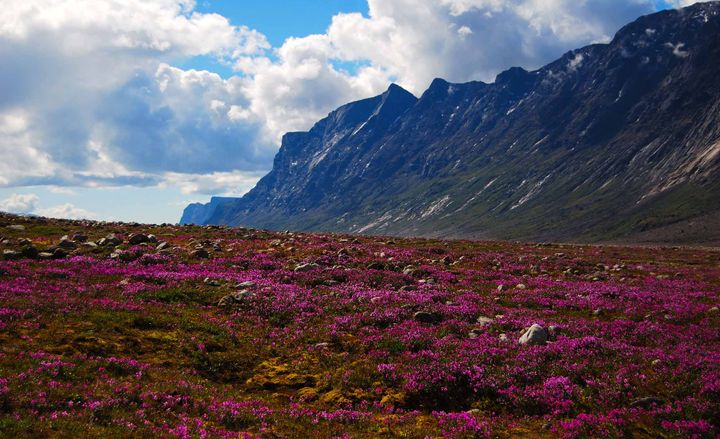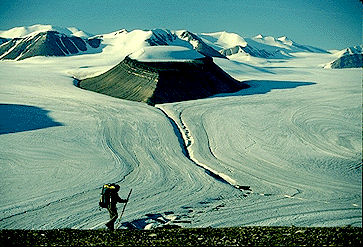Nunavut
Nunavut, which translates from the Inuktitut dialect of the Eastern Arctic Inuit as "Our Land," is a Canadian territory.

-
July 15, 1870

Government and Politics
Transfer of Rupert's Land
The British Crown officially transferred Rupert's Land and the North-Western Territory to Canada. These lands comprise present-day Manitoba, most of Saskatchewan, southern Alberta, southern Nunavut, and northern parts of Ontario and Québec.
-
December 31, 1876
Indigenous Peoples People
Death of Tookoolito
Inuit Arctic guide Tookoolito, also known as Hannah, died. Born on Cape Searle (in present-day Nunavut), Tookoolito joined exploration expeditions with her husband, Ipiirvik. They accompanied American explorer Charles Hall on his Arctic journeys, including the ill-fated Polaris expedition, during which the couple saved many of the crew from icy deaths.
-
September 01, 1880

Government and Politics
Arctic Sovereignty
British sovereignty over the Arctic Islands passed to Canada.
-
February 04, 1916

Sports and Culture
Birth of Pudlo Pudlat
Pudlo Pudlat, Inuk graphic artist whose work displays the paradoxes of the encounter between two cultures, was born at Kamadjuak Camp, Baffin Island, NWT.
-
August 19, 1928
Indigenous Peoples Sports and Culture
Birth of Qaqaq Ashoona
Inuit sculptor Qaqaq Ashoona, whose sculpture is acclaimed for the sense of monumentality and strength he imparts to animal and human subjects alike, was born at Ikerrasak camp, south Baffin Island, NWT (now Nunavut).
-
April 27, 1948

Sports and Culture
Birth of Michael Kusugak
Michael Kusugak, Inuit children's writer, was born at Repulse Bay, NWT.
-
May 05, 1949

Sports and Culture
Birth of George Arluk
George Arluk, Inuit artist and sculptor, was born in the Keewatin region, NWT. Arluk grouped figures together to form abstracted compositions of gently curving forms that undulate rhythmically.
-
January 01, 1950
Indigenous Peoples
Inuit Enfranchised
The Inuit were enfranchised without restrictions. However, the geographic isolation of northern communities meant that many did not have the opportunity to vote until ballot boxes were placed in all Inuit communities for the 1962 federal election.
-
January 01, 1971
Indigenous Peoples
Inuit Tapirisat of Canada
The Inuit Tapirisat of Canada (Tapirisat, meaning Brotherhood in English) was founded. The ITC was created by an organizing committee of Inuit who decided it was time to speak with a united voice on various issues concerning development of the Canadian North and preservation of Inuit culture. In 2001, the ITC was renamed the Inuit Tapiriit Kanatami.
-
September 30, 1973
Indigenous Peoples Sports and Culture
Death of Peter Pitseolak
Inuit photographer, historian and artist Peter Pitseolak died at Cape Dorset (Kinngait), NT (now Nunavut). Pitseolak spent most of his life in traditional camps during a time when life in the North was undergoing immense change. He used photography to document a way of life that many believed was disappearing.
-
January 01, 1976
Government and Politics
Nunatsiaq Riding Created
A federal riding was created in the Northwest Territories. Called Nunatsiaq, it represented territory that now comprises Nunavut.
-
January 01, 1976
Indigenous Peoples
Nunavut Land Claims Presented to Government
The Inuit Tapirisat of Canada submitted a formal land claims proposal to the Government of Canada.
-
January 01, 1982
Indigenous Peoples
Tungavik Federation of Nunavut Established
The Tungavik Federation of Nunavut (TFN) was established in order to negotiate a land claims agreement with the Government of Canada.
-
April 14, 1982
Government and Politics
Northwest Territories Plebiscite
The majority of voters (56 per cent) chose to divide the Northwest Territories in two in a territorial plebiscite. The division would create a mainly Inuit eastern territory. Over 80 per cent of the territory’s Inuit voted, more than 80 per cent of whom voted in favour of the creation of Nunavut. The results of the plebiscite were not binding federally.
-
May 28, 1983

Sports and Culture
Death of Pitseolak Ashoona
Pitseolak Ashoona, Inuk graphic artist known for her lively prints showing "the things we did long ago," died at Cape Dorset, NWT (now Nunavut).
-
January 01, 1988

Resources and Environment
Quttinirpaaq National Park Established
Quttinirpaaq National Park was established and was Canada's second-largest national park (after Wood Buffalo National Park). First known as Ellesmere Island National Park, Quttinirpaaq is Canada's most northerly national park and the most northerly land in North America. Its Inuit name, taken in 1999, reflects it location, "top of the world."
-
May 04, 1992
Government and Politics
Nunavut Boundary Plebiscite
A plebiscite was held in order to confirm the boundary between the Northwest Territories and Nunavut. Fifty-four per cent voted in favour of the proposed boundaries.
-
November 03, 1992
Indigenous Peoples
Inuit Accept the Terms of the Nunavut Land Claims Agreement
A majority of Inuit beneficiaries voted to accept the terms of the proposed Nunavut Land Claims Agreement. In tandem with the Nunavut Act, the land claims agreement led to the creation of the territory of Nunavut.
-
June 10, 1993
Government and Politics
Nunavut Act Receives Royal Assent
The Nunavut Act, which established the new territory and its government, received royal assent in Parliament. The territory's Inuit population became beneficiaries under the Nunavut Land Settlement Agreement, which also received royal assent on this day. Nunavut officially became Canada’s third territory on 1 April 1999.
-
September 06, 1996
Government and Politics
Residents Keep NWT Name
Residents of the Northwest Territories voted to keep that name for the western part of territory after the eastern part became the territory of Nunavut in 1999.
-
June 02, 1997
Government and Politics Indigenous Peoples
First Inuit MP Elected
Liberal Nancy Karetak-Lindell was elected the first Member of Parliament for the newly-created riding of Nunavut, and became the first Inuit woman elected to the House of Commons.
-
February 15, 1999
Government and Politics
First Woman Elected to the Nunavut Legislative Assembly
Manitok Thompson became the first woman elected to the Nunavut Legislative Assembly.
-
April 01, 1999

Government and Politics
Nunavut Declared
The new territory of Nunavut, covering some 2 million sqare kilometers of the eastern Arctic, was declared as part of Canada's first territorial changes since Newfoundland joined Confederation in 1949.
-
January 01, 2001

Resources and Environment
Auyuittuq National Park Established
Auyuittuq National Park was established. It was Canada's first national park located north of the Arctic Circle. It was first set up as a national park reserve in 1976 and established as a national park through the Nunavut Land Claims Agreement.
-
January 01, 2003

Resources and Environment
Ukkusiksalik National Park Established
Ukkusiksalik National Park was established. Located on the northwest side of Hudson Bay in Nunavut, it was first proposed as a National Park in 1978 because of the spectacular inland sea, Wager Bay, and the surrounding area. The name Ukkusiksalik in Inuktitut means "the place where soapstone to make pots and oil lamps is found."
-
November 14, 2008
Government and Politics
Aariak Becomes First Female Premier of Nunavut
Eva Aariak, the MLA for Iqaluit East and Nunavut's former languages commissioner, defeated Paul Okalik to become Nunavut’s second premier and the territory’s first female premier. She was, however, the only woman in the legislature.
-
November 29, 2011
Indigenous Peoples
Eeyou Marine Region Land Claims Agreement
The Eeyou Marine Region Land Claims Agreement, recognizing the Indigenous rights and title of the Cree of Eeyou Istchee, received assent. The land claims process began in 1974. The Agreement is unusual because it traverses boundaries. For instance, the settlement area includes a section of Northern Québec coastline and offshore islands claimed by Nunavut.
-
January 08, 2013

Sports and Culture
Kenojuak Ashevak Dies
Kenojuak Ashevak, a Nunavummiuq artist whose work became an icon of the Canadian Arctic, died at age 85 in her home at Cape Dorset, Nunavut.
-
September 09, 2014

Disasters
Franklin Expedition Ship Discovered
The HMS Erebus, one of Sir John Franklin's expedition ships, was found submerged off the coast of King William Island. The ship was part of Sir John Franklin's 1845 expedition to find the Northwest Passage from the Atlantic Ocean to Asia.
-
September 12, 2016

Disasters
Discovery of HMS Terror
A team from the Arctic Research Foundation (founded by Jim Balsillie) announced that they had found the second lost ship of the Franklin expedition, HMS Terror, in Nunavut’s Terror Bay, north of where the Erebus was found in 2014. The discovery was confirmed by Parks Canada on 26 September 2016.
-
October 14, 2021
Disasters Government and Politics Resources and Environment
State of Emergency Declared in Iqaluit Due to Tainted Water Supply
Two days after discovering petroleum hydrocarbons in Iqaluit’s water supply, the Government of Nunavut declared a state of emergency in the city. (See also Water Treatment; Water Pollution.) The first of at least five shipments of potable water arrived in Iaqluit by airplane. The water was distributed in rations of 16 litres per household. Officials believed the contamination was caused by the effects of melting permafrost on underground pipes.




